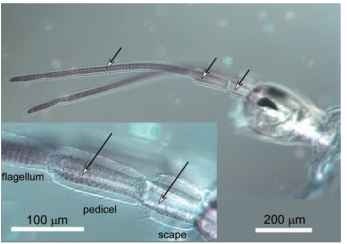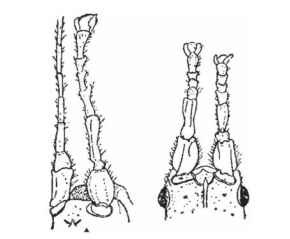Anoplura
Antennae
Antennae are segmented appendages that function primarily in chemoreception and mechanoreception. An insect has a single pair of antennae located on its head. Antennae in juvenile insects are often very different in morphology from antennae in adult insects, typically being larger or more elaborate in the adult stage. Adult antennae may be sexually dimorphic, appearing very different in males and females. Antennae are absent in the wingless hexapods belonging to the order Protura and may be extremely reduced in size in some holometabolous larvae.
STRUCTURE
The overall shape of most insect antennae is elongate and cylindrical (Fig. 1, top), although elaborations into plumose, lamellate, or pectinate forms have arisen many times in different insect lineages (Fig. 1, bottom). An elongate, cylindrical morphology, probably the ancestral condition for insect antennae, is found in fossil insects and many other arthropods. There are three parts to an insect antenna: the scape, the pedicel, and the flagellum (Fig. 2). The scape is the first

FIGURE 1 Insect antennae exhibit a variety of shapes including elongate morphologies (top) and those with lateral elaborations (bottom).

FIGURE 2 Muscles in the antennae of springtails (Collembola) (white; indicated by arrows) extend farther along the antennae than the muscles in the antennae of insects (to the proximal end of the terminal flagellomere vs. the proximal end of the pedicel, respectively). The inset shows a higher magnification view of the scape and pedicel of the springtail antenna.
segment (most proximal) of the antenna, and it is attached to the head by a rim of flexible, intersegmental cuticle. Thus, the scape (and the rest of the antenna) can move with respect to the head. All the anten-nal segments (and subsegments) are similarly joined to each other by thin, flexible cuticle.
The movements of an antenna are controlled in part by one or two pairs of muscles that attach inside the head (such as on the tentorium) with the other end attached inside the scape. An additional pair of muscles runs from the scape to the next segment of the antenna, the pedicel. The combined action of these two sets of muscles is capable of moving an antenna in almost any direction. The final (most distal) segment of the antenna, the flagellum, is the most variable in morphology among insects. The only hexapods that have intrinsic muscles in the flagellum (joining adjacent segments) are members of the wingless orders Collembola and Diplura (Fig. 2). In all true insects, there are no muscles in the flagellum. Many specialists prefer “annulus” or “sub-segment” to “segment” for an individual part of a flagellum in insects, because “segment” is reserved for parts with their own musculature. Movements of an annulated flagellum without intrinsic musculature may still occur, such as the spreading and closing of the lamellae or lateral extensions in an antenna (Fig. 1, bottom), but these movements are driven by changes in the pressure of the hemolymph (blood) inside the antenna and thus are hydraulic rather than muscular.
In most insects, circulation of hemolymph through an antenna is facilitated by muscular pumping by an accessory heart located in the head near the base of the antenna. This antennal heart pumps the hemolymph into a blood vessel that discharges the hemolymph at the distal end of the antenna. The return flow of the hemolymph back to the head (and the general open circulatory system of the insect) is not inside a blood vessel. The lumen of an antenna also contains tracheae and nerves, which branch into any lateral extensions of the flagellum. Sensory neurons that respond to chemical or physical stimuli terminate in the deutocerebrum of the brain. The deutocerebrum is also the site of origin for the motor neurons that stimulate the muscles associated with the antennae.
GROWTH AND DEVELOPMENT
Antennal growth and development in holometabolous insects (those that undergo complete metamorphosis) differs greatly from that in other insects. In holometabolous insects, adult antennae form from imaginal disks, which are clumps of undifferentiated cells that will develop into adult structures. The antennal imaginal disks may appear in the embryonic (fly) or late larval (moth) stage of the immature insect. Properties of the antennal imaginal disks determine to a large extent the chemical stimuli to which an adult will respond, as is seen from experiments in which antennal imaginal disks were cross-transplanted between larvae, which were then reared to adulthood and assayed.
In hemimetabolous and apterygote (wingless) insects, the nymphs are very similar in overall form and habit to the adults, and their antennae resemble smaller, shorter versions of the adult antennae. As with all external structures that are replaced at each molt, a new antenna is formed inside the old antenna. The primary morphological change that occurs at each molt is that the flagellum lengthens with the addition of more segments or annuli, either at the distal end (orders Collembola and Diplura), the proximal end (most insects), or along the length of the flagellum (some members of the orders Orthoptera and Odonata).
Antennae are serially homologous to mouthparts and legs, reflecting the ancestral condition of a single pair of appendages per body segment shared by arthropods and related groups. Common developmental features between legs and antennae can be seen, for example, in the action of the homeotic gene called Antennapedia, which results in the substitution of leglike appendages for antennae on the head when expressed ectopically in mutant Drosophila. Leglike appendages appearing in the antennal location in adult insects have also been observed after regeneration of antennae following injury during the larval stage (Fig. 3).

FIGURE 3 Left: head of an adult Indian stick insect (Carausius morosus) with a normal antenna on the left and a regenerated antenna with leglike morphology on the right. Right: head of adult C. morosus with two regenerated antennae with leglike morphology.
FUNCTION
The primary function of antennae is the assessment of the chemical and physical characteristics of the environment. Detection is made with innervated chemosensory and mechanosensory organs that are arrayed on the antennae. A single antenna usually has sensory organs of several types, with different properties. Most of the chemosensory organs are located on the flagellum and often take the form of microscopic chemosensory hairs (sensilla), each only 1 or 2 |im in diameter. Some antennae, such as the feathery pectinate antennae of silkworms (Bombyx mori), have tens of thousands of sensilla, which are capable of very thoroughly sampling the air that passes in the small spaces between them. A cockroach antenna may have hundreds of thousands of sensilla. The chemicals that may be detected by chemoreceptors on the antennae are usually biological in origin and airborne (volatiles), although (depending on the insect species) the sampled chemical compounds are sometimes in a liquid or associated with a solid surface. The chemicals intercepted by antennae may alert the insect to the presence of prospective mates, food, suitable places to lay eggs, or predators.
The physical stimuli detected by mechanoreceptors on the antennae may be used by the insect to indicate airspeed during flight, to detect vibrations of the air, or to detect solid boundaries in its environment by touch. Although a single mechanosensory hair will send information to the brain about the local physical conditions existing at its microscopic location, an antenna also has mechanosensory organs that evaluate the physical forces acting on the antenna as a whole. These mechanosensory organs, located near the base of the antenna, include Johnston’s organ, Bohm bristles, hair plates (groups of mechanosensory hairs), and campaniform sensilla (thin, flexible patches of cuticle that are innervated). Johnston’s organ is located in the pedicel and responds to changes of location or vibrations of the whole antenna. In contrast, the Bohm bristles, located near the scape-pedicel boundary, send information to the brain about the antennal position, rather than its movements. The variety of mech-anosensory organs associated with the first two segments of the antennae are believed to act together to inform a flying insect about its airspeed, because greater flying speed will cause greater deflection of the antennae by the air rushing past. Contact chemosensory hairs, so called because the chemical compounds are usually detected when the insect is touching a liquid or solid surface with the antennae, often have mechanosensory capabilities as well and are usually located near the distal ends of antennae.
The function of the antennal sensory organs will be affected by their arrangement on the antennae. For example, sensory organs on the distal tip of a very long antenna will permit chemical or physical sampling of the environment far from the body of the insect. Close packing of sensory hairs will decrease the airflow in their vicinity, and hence will modify both the chemical and physical sampling of the environment by those hairs. The function of the antennae will also be dependent on the behaviors of the insect that will affect the airflow around the antennae, such as flying, wing fanning, postural changes, or oscillating the antennae. A structure projecting into the environment is liable to collect debris that might interfere with its sensory function; both antennal grooming behaviors and modifications of leg parts against which an antenna is scraped are common in insects. In some insects and other hexapods, antennae are modified for nonsensory functions such as clasping mates during copulation (fleas and collembolans), holding prey items (beetle larvae), or forming a temporary physical connection between an underwater air reservoir and the atmosphere (aquatic beetles).
